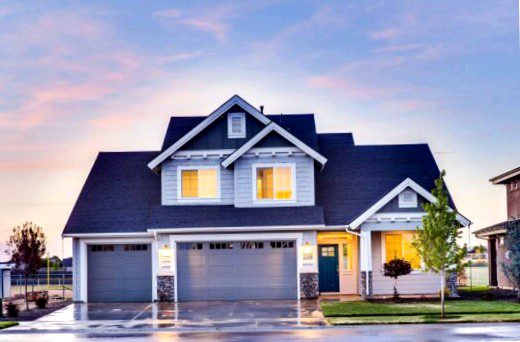Better to have a short or long fixed interest rate?

The fixed interest rate is one of the most important decisions when choosing a construction financing loan. This term determines not only the interest rate but also what risk you take. For all those who do not seek full repayment of the loan – that is, repayment in full within the term of the initial financing, must refinance the remaining debt after expiration with a follow-up financing. But who can estimate today how z. B. In 20 years the construction interest rate quoted? If the interest rate has risen massively at this point, there is a threat of a much more expensive follow-up financing of the remaining debt. On the other hand, a full amortization loan costs much higher interest during the fixed term compared to a very short fixed interest rate of 5 years. What factors play a role in the decision?
The interest rate trend over the last 40 years
If one regards the interest development of the past, then immediately one notices that building money interest 2022 is still favorable. Even if at the beginning of 2022 the time of historically low construction money interest rates was over and a trend reversal can be observed.
- In 1980, the average interest rate in construction financing was over 11 percent,
- after that it fell until 1985 to ca. 6 percent,
- to rise again to 11 percent by 1990.
- Since then, the interest rates have been continuously decreasing: 2000 to ca. 6 percent,
- to 5 percent until 2008,
- In 2011, the interest rate was approx. 4 percent the rule.
- Between 2015 – 2018, interest could be paid for approx. 1.5 percent received,
- while afterwards up to 2020 under 1 per cent were possible.
- Currently, the interest rate for real estate loans tends to be around. 2.4 percent.
In summary, the current interest rate in 2022 is still favorable by historical standards. Before 2015, such an interest rate was neither realistic nor expectable. It was only through the effects of the financial crisis, through the massive interventions of central banks and politicians that these historic low interest rates came about after 2015, but their time now seems to be over for the time being.
The influence of the fixed interest rate on the interest rate
The period of the fixed interest rate can be set individually. It is common to fix the interest rate for 5, 10 or 15 years. However, longer debit interest commitments of 20, 25 or even 30 years can also be agreed. But the longer the fixed interest rate, the higher the agreed interest rate, as a rule. This is because the bank pays for a longer term by charging an interest rate premium in order to cushion the risk of further increases in interest rates on the interest rate market. This can be seen as a kind of insurance premium for the bank. On average, the interest rate on a 20-year fixed-rate mortgage is currently about 0.5 percent higher than on a 10-year mortgage.
When deciding on the term of a construction financing contract, there is a rule of thumb: If one expects construction interest rates to fall in the future, it is advisable to have a short debit interest commitment of z. B. five years. True, then, at the end of the contract, the loan is usually not fully repaid. But with the follow-up financing then required, the borrower has the opportunity to secure the lower interest rates that may then be in effect five years from now. Conversely, if construction interest rates rise, borrowers should choose the longest possible fixed-interest period. This means that the interest rates, which are still favorable at this point in time, are also secured for the future.
Experts therefore recommend in 2022, with the current still favorable interest rate level to choose a long interest rate fixation. This is because the borrower has the option to unilaterally terminate longer-term loan agreements after ten years have elapsed, in order to then obtain more favorable follow-up financing. However, a particularly long fixed interest rate also makes the construction loan more expensive.
Interest rate fixation in the current comparison
The following interest rates depending on the fixed interest rate will be applied in May 2022 for an average annuity loan – new construction of an owner-occupied single-family house, loan amount 400.000 euros, equity 100.000 euros with 3 percent repayment – offered on average by the financing bank:
- Debit interest rate fixed for 5 years – effective annual interest rate: 2.48%
- Fixed interest rate for 10 years – effective annual interest rate: 2.68%
- Debit interest rate fixed for 15 years – effective annual interest rate: 3.04%
- Fixed interest rate for 25 years – effective annual interest rate: 3.52%
The figures of one of the large German construction financing intermediary portals europace show that in the last 6 months the demand for short interest rate fixings of 5 years has fallen massively and is now tending towards zero. 10 year construction financing as well as construction financing, which run longer than 15 years, hold themselves meanwhile with in each case scarcely 50% demand the balance. This trend shows that borrowers expect interest rates to rise in the long term and therefore prefer long-term fixed interest rates to play it safe.
The choice of fixed interest rate is always an individual question
Ultimately, it is always about the future of the borrower. Good construction financing advice must take into account the borrower's life situation and life plans. This can then possibly also lead to the fact that a short fixed interest rate despite the uncertainties of rising interest rates or the division of different construction financing loans with different lengths of fixed interest rates is useful. For example, if the borrower can count on an inheritance in the future, which is used to pay off a short-term loan agreement in one sum after it expires.
But also the questions about government support programs and subsidies, especially for new construction financing, must be considered. Because here the question arises whether the high requirements, which influence the cost of the new building, z. B. justify a KfW loan, which may grant only slightly more favorable interest rates than offers of the free market. Or whether the purchase of an existing property fits better into the borrower's financial framework, as much higher grants and subsidies can be expected here.
The question of the type of loan must also be answered: does it necessarily have to be an annuity loan?? Or could z. B. a bullet loan – i.e. a loan that does not provide for repayment – could even be an alternative, in which case the borrower would repay the loan in full after it expires? The most important argument in favor of a long fixed-interest period is calculation security. If you finance with little equity, financing for as long as possible, and therefore more expensive, seems very sensible and secure. In the end, the exact analysis of the own financial situation, the weighing of the possibilities and exact and "unadorned" calculation is the order of the day. And this is best done with an experienced construction financing consultant who knows the best possible Angbebote on the credit market of real estate financing, independent of banks.

Term, interest rate comparison and repayment – what to look out for in times of fluctuating interest rates for secure financing.